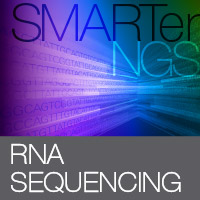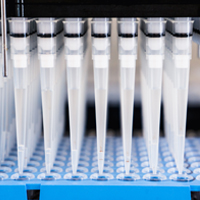Cancer transcriptome analysis with total RNA-seq
Use whole transcriptome sequencing to discover biomarkers crucial in understanding the onset or progression of cancer and other diseases with Takara’s Total RNA-seq kits. Backed by their unrivaled sensitivity and low input requirements, these kits work seamlessly with a broad range of sample types, including FFPE RNA, cell-free RNA, exosomes and extracellular vesicles (EVs), and single cells.
- High-quality libraries from a broad range of sample types, inputs, and quality – Fresh, fresh-frozen, and highly degraded FFPE samples (10 pg-10ng total RNA, RIN 3-10), or cells (1-1,000).
- Ability to capture coding and non-coding transcripts with high sensitivity & specificity – Detect mRNA, non-PolyA RNA, long non-coding RNA (lncRNA) species with strand-of-origin information.
- All-inclusive kit for library prep with built-in ribosomal RNA depletion – Simple, cost-effective, robust single-day protocol ~7h
- Improve data accuracy – With unique molecular identifiers (UMIs) and unique dual indexes (UDIs)
Dive deeper
Get high-quality data from degraded FFPE samples
The Pico v2 kit enables good representation of desirable RNA types in a single sequencing experiment, allowing researchers to detect a broad range of different biomarkers from both coding and noncoding RNAs even from low quality, degraded FFPE samples. Get the most out of FFPE RNA. More information »
Accurately quantify transcripts and identify true variants with unique molecular identifiers (UMIs)
The Pico v3 kit enables seamless integration of UMIs into the protocol that help mitigate PCR duplicates and bias and accurately identify true variants and rare mutations. More information »
Accurately detect RNA transcripts from extracellular vesicles
The Pico v2 kit provides an accurate, precise, and sensitive method to quantify total RNA in human biofluids including the contents of extracellular vesicles derived from different biofluids. More information »
Remove unwanted transcripts with ZapR™
The Total RNA-Seq kits (Pico v3, Pico v3, and SMART-Seq Stranded) include a fully integrated method for removal of unwanted transcripts such as rRNA at the cDNA level—in contrast to other available strategies that are either very sample hungry or ineffective on small input quantities. More information »
High-quality single-cell transcriptome profiling in primary cryopreserved tissue
Automated miniaturization of experiments saves on both cost and labor by decreasing reaction volume and minimizing the hands-on work. To this end, research and core facilities at the Van Andel Institute developed Single-cell Total RNA Miniaturized sequencing (STORM-seq) as a collaborative effort with Takara Bio. Leveraging the SPT Labtech mosquito HV liquid handler, STORM-seq is a nanoliter-scale, plate-based, single-cell, total RNA approach to yield high-resolution libraries that rival full-volume reactions from both cryopreserved human and mouse tissues. More information »
CHOOSE THE RIGHT KIT FOR YOUR APPLICATION
| SMARTer Stranded Total RNA-Seq Kit v3 - Pico Input Mammalian (Pico v3) |
SMARTer Stranded Total RNA-Seq Kit v2 - Pico Input Mammalian (Pico v2) |
SMART-Seq Stranded Kit | |
| Input | 250 pg–10 ng, total RNA, 10–1,000 cells |
250 pg–10 ng, total RNA | 10 pg–10 ng, total RNA, 1–1,000 cells |
| FFPE compatible | Yes | Yes | No |
| RNA integrity | RIN 3–10; DV200>25% (including FFPE) |
RIN 3–10; DV200>25% (including FFPE) |
RIN 3–10 |
| rRNA removal | H/M/R* rRNA | H/M/R rRNA | H/M/R rRNA |
| UDIs | 384 UDIs | 384 UDIs | 384 UDIs |
| UMIs | Yes | No | No |
| Workflow time | ~7.5 h | ~6 h | ~7 h |
*H/M/R = human, mouse, rat
Takara Bio USA, Inc.
United States/Canada: +1.800.662.2566 • Asia Pacific: +1.650.919.7300 • Europe: +33.(0)1.3904.6880 • Japan: +81.(0)77.565.6999
FOR RESEARCH USE ONLY. NOT FOR USE IN DIAGNOSTIC PROCEDURES. © 2025 Takara Bio Inc. All Rights Reserved. All trademarks are the property of Takara Bio Inc. or its affiliate(s) in the U.S. and/or other countries or their respective owners. Certain trademarks may not be registered in all jurisdictions. Additional product, intellectual property, and restricted use information is available at takarabio.com.












